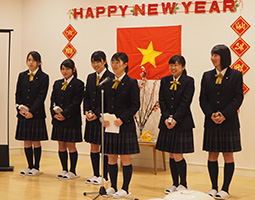INDEX
- English
- 日本語

The students’ dishes of (left) rice cooked with a variety of ingredients, (center) kushikatsu skewers of deep-fried meat and vegetables, and (right) spring rolls, all prepared using GAP-certified ingredients - English
- 日本語

Fukushimameisei High School students with some of the dishes they prepared for the Omotenashi Contest



An exchange event attended by Vietnamese people living in Fukushima City, January 2020 
A mousse cake topped with locally grown GAP-certified apples and peaches
June 2021
Omotenashi with “GAP Foods”



As part of the Host Town Initiative, in which people in Japan interact with people from countries and regions participating in the Tokyo 2020 Olympic and Paralympic Games, students of agricultural high schools across Japan have been taking on the challenge of providing omotenashi (hospitality) with foods certified as conforming to Good Agricultural Practice (GAP).

Foods used at the Olympic Village are procured based on the Sustainable Sourcing Code created by the Tokyo Organising Committee of the Olympic and Paralympic Games. The Code defines individual criteria for the sustainable sourcing of a variety of products including agricultural products, livestock products and fishery products. Within these individual Sourcing Codes, certification systems such as Good Agricultural Practice (GAP) are positioned as confirming that all the necessary conditions are satisfied in terms of food safety, environmental conservation and worker safety, while for livestock products, animal welfare* is also included. In recent years, major global distributors and food companies have started to require GAP certification in their terms and conditions, and in Japan the number of agricultural producers actively taking on GAP is increasing.
From the perspective that the dissemination of GAP certification, as a feature of the Sustainable Sourcing Code, will be a legacy of the Tokyo Games, the Secretariat of the Headquarters for the Tokyo 2020 Olympic and Paralympic Games of the Cabinet Secretariat implemented the Omotenashi Contest with GAP Foods in FY2019. At this event, students from agricultural high schools across Japan proposed their plans to develop dishes using GAP foods produced at their schools and to welcome people including athletes who come to their Host Towns with Japanese hospitality (omotenashi). Against this background, the move to take on GAP certification has become widespread among agricultural high schools in Japan. Of the forty teams which participated in the contest across Japan, five were from Fukushima Prefecture. Since Fukushima Prefecture declared its intention to be Japan’s number one GAP prefecture, the number of agricultural producers and agricultural high schools taking on GAP certification has been increasing. Now, all agricultural high schools in the prefecture have acquired GAP certification for their agricultural products.
Founded in 1896, Fukushimameisei High School is one such agricultural high school. The school has about 30 hectares of farmland, including pastures and related facilities, and has received GAP certification for twenty-one agricultural products—the most among the teams participating in the Omotenashi Contest.
Fukushima City, where the school is located, is the Host Town for athletes representing the Socialist Republic of Vietnam (hereinafter “Vietnam”). Initially, eight second-year students at the time of the contest thought about how to provide hospitality to Vietnamese athletes through food. They then considered how to use GAP foods and whether to base their foods on Japanese or Vietnamese cuisine. Together, they came up with an idea to base the food on Vietnamese cuisine but also include characteristics of Japanese and Fukushima cuisine.
Tateshita Hiroe, the teacher who guided the students, recalls how at the time “students stayed at school after classes to create menus and experiment, while researching the features of Vietnamese culture and food, and taking advice about ingredients used in Vietnamese cuisine from many teachers.”
What they created were dishes with the “five flavors, five colors, and two aromas”** traditionally considered by Vietnamese people to be the ideal. Specifically, they created five foods: spring rolls using rice (a staple in Vietnam) and rice flour; rice cooked with various ingredients; kushikatsu deep fried skewers of a variety of meats and vegetables; and finally Swiss rolls and mousse cakes that made generous use of Fukushima peaches and apples.


Due to the effects of COVID-19, the students have not been able to show their hospitality to the Vietnamese athletes in person, but in addition to the students’ food being introduced on websites, the students were able to entertain by inviting Vietnamese people living in Fukushima City to an exchange event held in January, 2020. Through the food they devised, the students were able to interact with Vietnamese people and also spread understanding of the excellent GAP foods produced by Fukushimameisei High School.
The ambitious work of these eight students, who graduated in spring of this year, was not only a vital experience for the students themselves, but it also serves as a valuable example of how interactions through food can lead to understanding between countries.
* Suppliers are required to procure "livestock products produced by taking appropriate measures to raise livestock animals in a comfortable environment with reference to the Animal Welfare-oriented Livestock Management Standards.” (Sustainable Sourcing Code for Livestock Products)
** A phrase expressing the ideal model for Vietnamese cuisine. The five flavors are salty, sour, spicy, sweet, and richness and the five colors refer to white, yellow, green, red, and black. The two aromas refer to aromas and fragrances.

